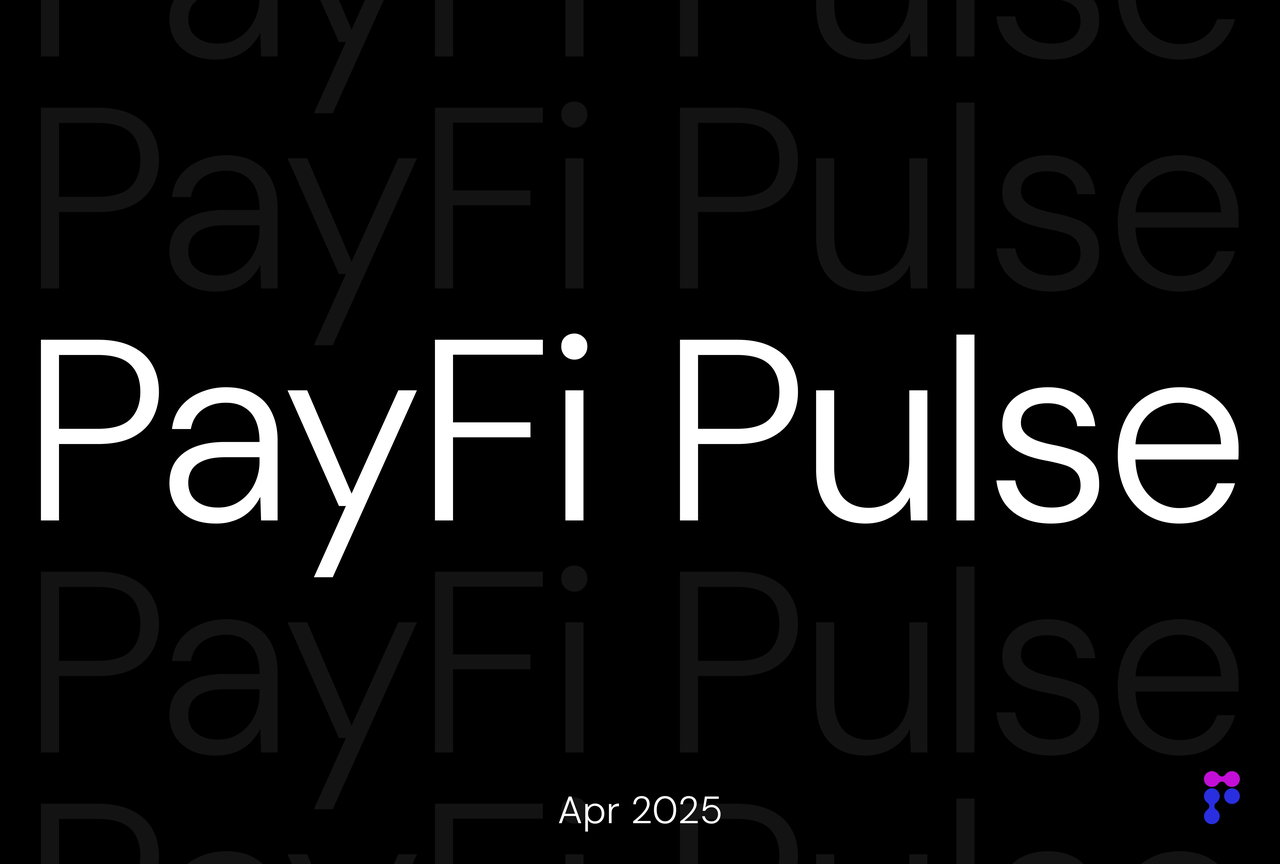The PayFi Report 2025 (Apr) by PolyFlow
Despite the continued buzz surrounding PayFi, its foundation relies significantly on the broad adoption of stablecoins. In the April market, we note that with regulatory clarity under the new U.S. framework, many fintech giants are entering the arena. Whether by participating in stablecoin issuance, developing their own stablecoin payment networks, or entering through investments and acquisitions, fintech firms are poised to dominate the future stablecoin market, as to the further application of

Despite the continued buzz surrounding PayFi, its foundation relies significantly on the broad adoption of stablecoins. In the April market, we note that with regulatory clarity under the new U.S. framework, many fintech giants are entering the arena. Whether by participating in stablecoin issuance, developing their own stablecoin payment networks, or entering through investments and acquisitions, fintech firms are poised to dominate the future stablecoin market, as to the further application of PayFi. Let’s dive in.
Data Tells
A recently published report by Citi GPS revealed that by April 2025, the circulating supply of stablecoins exceeded $230 billion, representing a 54% increase compared to April 2024. The stablecoin market is predominantly dominated by two major players, Tether (USDT) and USD Coin (USDC), which collectively hold over 90% of the market share in terms of transaction volume and value.
There has been a rapid surge in stablecoin transaction volumes over recent years. Adjusted figures indicate that these volumes reached between $650 billion and $700 billion per month during the first quarter of 2025. This is nearly double the volume observed from the latter half of 2021 through the first half of 2024. The primary use of stablecoins has been to support the broader crypto ecosystem.
Beyond stablecoin's role in the crypto trading ecosystem, stablecoins are also pivotal in payment systems, especially for cross-border transactions. While the total transaction volume of stablecoins might eventually exceed that of the current VISA and Mastercard transaction volume, the Citi GPS report includes a visual comparison with adjusted Visa data, providing a clear insight. Despite the increasing significance of stablecoins, there remains a considerable journey ahead.
As noted by Matt Blumenfeld, Global and US Digital Assets Lead at PWC, we can anticipate an influx of market participants, particularly from banks and traditional financial institutions. USD-backed stablecoins are expected to maintain their dominance. Ultimately, the number of participants will depend on the variety of products needed to cover major use cases, and this market will likely feature more players than the card network industry.
Fintech Giants are Entering the Fray
The evolving crypto landscape in the United States is significantly influencing how businesses move, hold, store, and monetize payments. Paul S. Atkins, recently sworn in as the chairman of the SEC, is anticipated to bring regulatory clarity to the digital asset space, a move welcomed by industry advocates.Stablecoins have reached an adoption level that is capable of revolutionizing global money transfers, akin to how WhatsApp transformed international communication, as noted by a16z. Financial giants are now gearing up and beginning to enter this burgeoning market.
Circle Payment Network
In a notable advancement, Circle, the company behind the $60 billion USDC stablecoin, launched the Circle Payments Network (CPN). This new payment and cross-border remittance network aims to tackle enduring challenges in cross-border payments. These inefficiencies, driven by intermediary layers, compliance requirements, and jurisdictional fragmentation, particularly impact emerging markets. By offering a streamlined, modern alternative, Circle seeks to reshape this landscape.
The CPN is designed to modernize the fragmented cross-border payment environment by enabling financial institutions to transfer money globally at the speed, transparency, and programmability reminiscent of the internet. It facilitates real-time settlements and ensures regulatory compliance through a robust governance framework, including licensing, AML/CFT compliance, cybersecurity protocols, and risk management standards. The launch event targets a diverse audience, including banks, fintechs, payment service providers, remittance providers, and USDC strategic partners. Initially focusing on remittances, Circle's new network has ambitions to eventually rival giants like Mastercard and Visa.
CPN supports a wide array of financial use cases, from supplier payments and remittances to treasury operations and capital markets settlement. Built on smart contract infrastructure and modular APIs, it allows third-party developers to create advanced financial modules, services, and workflows atop the network. To ensure high operational integrity, Circle has partnered with leading global banks, including Banco Santander, Deutsche Bank, Société Générale, and Standard Chartered.
Circle CEO Jeremy Allaire emphasized the vision of simplifying money transfers to the ease of sending an email, with CPN representing a significant step toward achieving this goal for businesses worldwide. This initiative not only positions Circle as a formidable player in the financial services sector but also underscores the transformative potential of stablecoins in enabling efficient, compliant, and real-time global financial transactions.
Stripe’s Stablecoin Application
Stripe has introduced new products leveraging artificial intelligence (AI) and stablecoins to foster business growth. The company unveiled the Payments Foundation Model, an AI-driven system aimed at improving fraud detection and authorization rates, honed through tens of billions of transactions. This model is particularly adept at countering card testing attacks by capturing subtle signals in payments.
Furthermore, Stripe launched Stablecoin Financial Accounts, enabling businesses to transact in stablecoins across 101 countries. These accounts currently support USDC and USDB, with plans to expand to additional currencies. To facilitate stablecoin spending at businesses that only accept fiat, Stripe's Bridge platform has partnered with Visa to issue cards linked to stablecoin wallets, allowing purchases at any merchant accepting Visa. Bridge CEO Zach Abrams described this innovation as a pivotal step in making stablecoins practical for everyday transactions by utilizing the familiar card payment system for ease of use.
Stripe CEO Patrick Collison highlighted the transformative effects of AI and stablecoins, underscoring their role in delivering immediate business benefits. AI has notably contributed to Stripe's success, resulting in a 38% increase in payment volume in 2024.
Global Dollar Network (USDG)
Visa is reportedly set to join the Global Dollar Network (USDG), a stablecoin consortium led by U.S.-regulated firm Paxos, marking its entry as the first traditional finance entity in the group. This consortium, which includes major players like Robinhood, Kraken, Galaxy Digital, Anchorage Digital, Bullish, and Nuvei, focuses on creating connectivity and liquidity while sharing yield among participants.
The USDG, introduced in November, launched a USD-pegged stablecoin to enhance global stablecoin use and provide economic benefits to its partners. Stablecoins are evolving from crypto exchange tools to becoming integral components of real-world financial infrastructure, increasingly used in B2B payments, capital markets, and treasury management. Visa's involvement aligns with its strategic initiatives in the crypto sector. This move underscores Visa's commitment to innovation and leadership in digital payments.
Race at Banking Charters
Crypto firms like Circle, Paxos, and Coinbase are actively seeking bank charters to enter the regulated banking sector. This initiative arises as traditional banks have distanced themselves from crypto clients following industry setbacks. Securing bank charters would enable these firms to hold customer deposits, manage stablecoin reserves, and offer banking services under regulatory oversight. Stripe is the latest to seek a special banking charter, building on Fiserv's previous efforts. Payment processors are drawn to this path to reduce costs and broaden their business models, motivated by the prospect of processing transactions directly.
As crypto firms transform into regulated entities, they become more appealing to businesses that were previously cautious due to reputational or regulatory concerns. This change could alter how Fortune 500 companies engage with crypto service providers, now viewed as stable and supervised. Business leaders should remain informed and ready for the increasing integration of crypto into the financial ecosystem.
Investment Trend in April
On April 15, 2025, Tether made a strategic investment in Fizen, a fintech company specializing in self-custody crypto wallets and digital payments. This investment highlights Tether's dedication to enhancing financial accessibility and security in the digital asset ecosystem. Fizen's advanced payment technologies enable seamless stablecoin transactions, making digital assets more accessible.
Fizen aims to address challenges faced by the unbanked, as highlighted by the World Bank, by enhancing blockchain capabilities and integrating stablecoins across ecosystems. This will provide efficient and user-friendly stablecoin solutions. Despite stablecoins' advantages, such as lower fees and enhanced security, their adoption in everyday commerce faces hurdles, particularly in merchant usage. Fizen seeks to bridge this gap by enabling seamless stablecoin payments, with merchants receiving instant fiat settlements via QR codes and card readers. With QR code payments predicted to exceed $3 trillion by 2024, the Tether-Fizen collaboration aims to accelerate crypto payment adoption, promoting seamless digital transactions.
Inflow has revealed a $1.1M pre-seed funding round, backed by investors such as AllianceDAO, Rockstart, and GnosisVC. This investment will enhance Inflow's mission to deliver a self-custodial, cost-effective, and quicker global payment solution tailored for freelancers and businesses in emerging markets. Currently burdened by high fees and lengthy settlement times, these users will benefit from Inflow's platform, which enables near-instant payments from international clients, thus providing financial freedom. By significantly lowering fees and settlement durations, Inflow ensures freelancers and agencies maintain full control over their funds. The company also plans to extend its services to assist e-commerce businesses facing similar hurdles.
With $7 million raised from investors like Dragonfly Capital and Andreessen Horowitz, Zar aims to facilitate cash-for-crypto exchanges at local stores using stablecoins such as USDT and USDC, which are increasingly popular for cross-border payments and inflation protection. Zar plans to leverage the infrastructure of over 28 million global registered mobile money agents who currently handle more than $1.5 trillion in financial services annually. Envisioned as a physical-world exchange akin to Coinbase's online model, Zar has already garnered interest from nearly 100,000 waitlisted customers and about 7,000 vendors across 20 countries, including Pakistan, Bangladesh, Indonesia, Nigeria, Lebanon, and Argentina. The process for customers involves visiting a local store, scanning a QR code linked to the Zar app, reviewing vendor ratings, and specifying the cash amount for stablecoin exchange, which is then deposited directly into their digital wallet.
Overall in April
With increasingly crypto-friendly regulations, particularly in the United States, numerous fintech giants are venturing into the stablecoin sector. Companies like Circle, which commands over a 25% share of the stablecoin market, are expanding their payment networks, while Stripe has begun integrating stablecoins into its ecosystem following its acquisition of Bridge.The stablecoin market has evolved beyond being just a playground for new entrants, as competition now focuses on the control of distribution channels. The key to a competitive edge in stablecoins lies in dominating currency usage scenarios. As a result, investments are increasingly directed towards application scenarios that support stablecoin utilization, especially in the payments sector.
About PolyFlow
PolyFlow is an innovative PayFi protocol designed to connect real-world assets (RWA) with decentralized finance (DeFi). As the infrastructure layer of the PayFi network, PolyFlow integrates traditional payments, crypto payments, and DeFi in a decentralized manner to handle real-world payment scenarios. PolyFlow provides the necessary infrastructure to ensure compliance, security, and seamless integration of real-world assets, paving the way for a new financial paradigm and industry standards.
SOCIALS
To find out more about PolyFlow and keep up with our latest developments, follow the official channels.📣Mirror | 💬 Global Community | 👾 Discord| 🐦 Twitter/X | 🌐 Website
CONTACT US
support@polyflow.tech

The PayFi Report 2025 (Apr) by PolyFlow
Despite the continued buzz surrounding PayFi, its foundation relies significantly on the broad adoption of stablecoins. In the April market, we note that with regulatory clarity under the new U.S. framework, many fintech giants are entering the arena. Whether by participating in stablecoin issuance, developing their own stablecoin payment networks, or entering through investments and acquisitions, fintech firms are poised to dominate the future stablecoin market, as to the further application of

Interview with PolyFlow CFO: When Payments Build Onchain Credit — PayFi Reconstructs Financing
In the traditional financial system, “payment” is often regarded as the end state of value transfer. But in the world of PayFi, it marks the beginning of value creation. When Visa can process tens of thousands of transactions per second but still requires several days for cross-border settlement, and when small and medium-sized enterprises shoulder a 6.5% cost on international payments while still having to pre-fund transactions, a financial revolution is quietly fermenting through on-chain paym

PolyFlow Insights: Rethinking Financial Systems Through Blockchain
The article is sourced from the Forbes Finance Council. Original article link: https://www.forbes.com/councils/forbesfinancecouncil/2025/03/28/drawbacks-of-traditional-financial-systems-and-how-blockchain-tech-can-help/ Raymond Qu | Cofounder PolyFlow, aiming to transform the global payment landscape & create efficient, innovative pay solutions | Geoswift. The traditional financial system has long been the backbone of global commerce, enabling economic growth. However, despite its many strengt